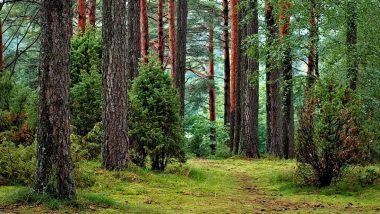Forests are the heart of the ecosystem as they are the habitats for animals and livelihoods for humans. Forests offer all its goodness to living beings. They provide habitat for animals, livelihoods for humans, prevent soil erosion and mitigate climate change. However, forests are not being treated the way, the way it deserves. They are slowing disappearing from the face of Earth due to man's selfish desires. International Day of Forests is held annually on March 21 to raise awareness on the importance of forests and their vital role in the eradication of poverty, environmental sustainability and food security.
As we celebrate International Day of Forests 2020, we take a look at incredible dense forests around the world. Ancient Baobab Trees Called 'Tree of Life' Are Slowly Dying Due to Climate Change in Southern Africa: Research.
The United Nations General Assembly proclaimed March 21 as the International Day of Forests in 2012. The day celebrates and raises awareness of the importance of all types of forests. The theme for each International Day of Forest 2020 is Forests and Biodiversity.
1. Congo Basin
The Congo Basin is the sedimentary basin of the Congo River. It is the second-longest river in Africa and produces the second largest contiguous rain forest on the planet along with its tributaries. The forest runs through six African countries like Cameroon, Central African Republic, Gabon, Congo and Zaire. It stretches from the Mountains of the Moon in the eastern Democratic Republic of Congo to the coast of the Gulf of Guinea.
2. Eastern Australian Temperate Forests
Eastern Australian Temperate Forests or temperate eucalypt forests, are an ecoregion of open forest on uplands starting from the east coast of New South Wales in the South Coast to southern Queensland, Australia. It comprises a wide variety of vegetation including coastal, dense heath, temperate rainforest, riparian communities, wet sclerophyll forests, dry sclerophyll forests, and eucalyptus woodlands. However, according to researchers from the Australian National University, the forest has been found to be home to the world's most carbon-dense forests.
3. Southeast Asia
The Southeast Asian rain forests are present since Pleistocene Epoch which is more than 70 million years. They are the oldest, most consistent rain forests and Earth's most biologically diverse forest. They stretch from India and Burma in the West to Malaysia and the islands of Java and Borneo in the East.
4. Amazon Basin
Amazon is the world's second-longest and the most voluminous river spread across nine countries. Amazon basin in South America is home to the world's largest tropical rain forest. It has the greatest variety of plants and animals on Earth, spread across 5,500,000 square kilometres.
5. Taiga Biome
The Taiga biome also known as Boreal forest, stretches across a large portion of Canada, Europe and Asia. It is the largest biome in the world and experiences a harsh continental climate. The taiga is home to a number of large herbivorous mammals and smaller rodents.
On each International Day of Forests, countries are encouraged to organise activities involving forests and trees, such as tree-planting campaigns to make people aware of the importance of trees. Around 1.6 billion people including more than 2,000 indigenous cultures depend on forests for their livelihoods, medicines, fuel, food and shelter. It is important to understand the role of forests and preserve it. This International Day of Forests, let's take a pledge to save our forests from further destruction.
(The above story first appeared on LatestLY on Mar 21, 2020 11:00 AM IST. For more news and updates on politics, world, sports, entertainment and lifestyle, log on to our website latestly.com).













 Quickly
Quickly





















